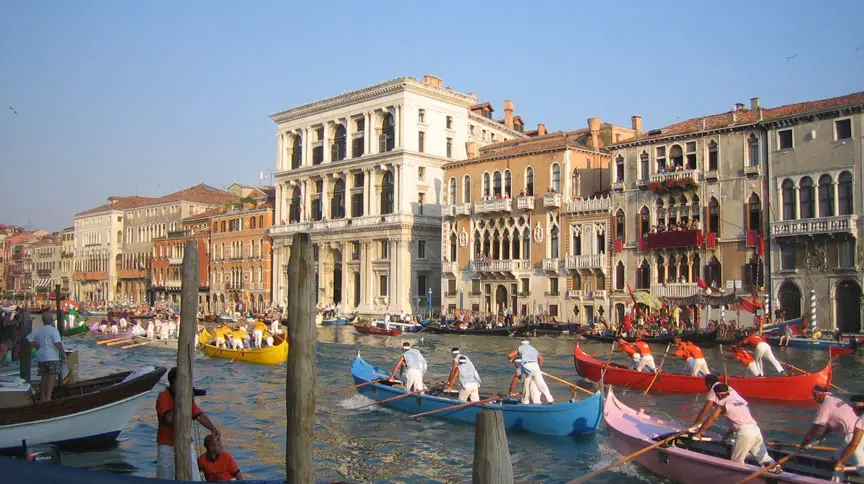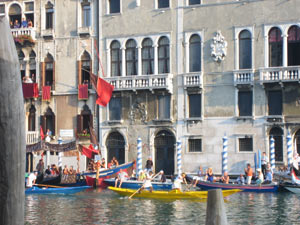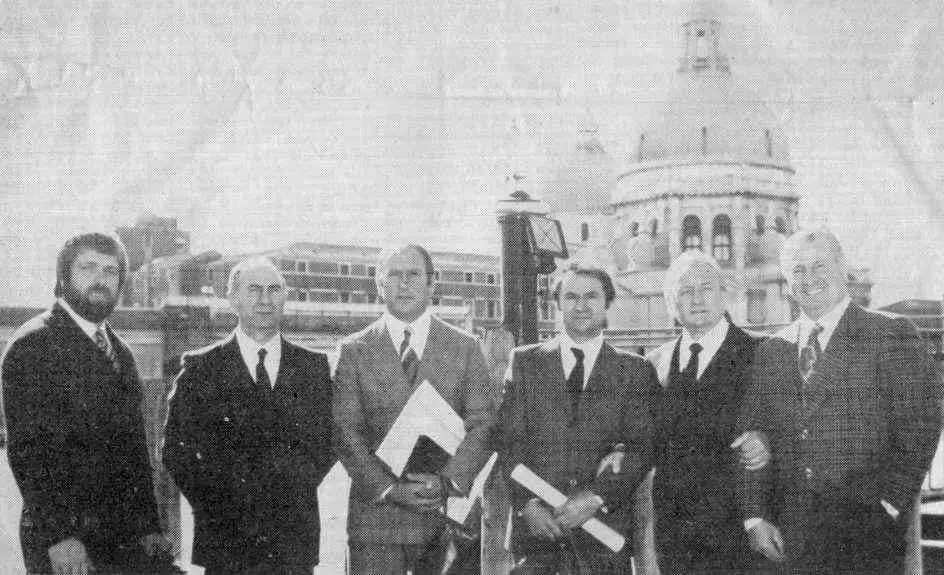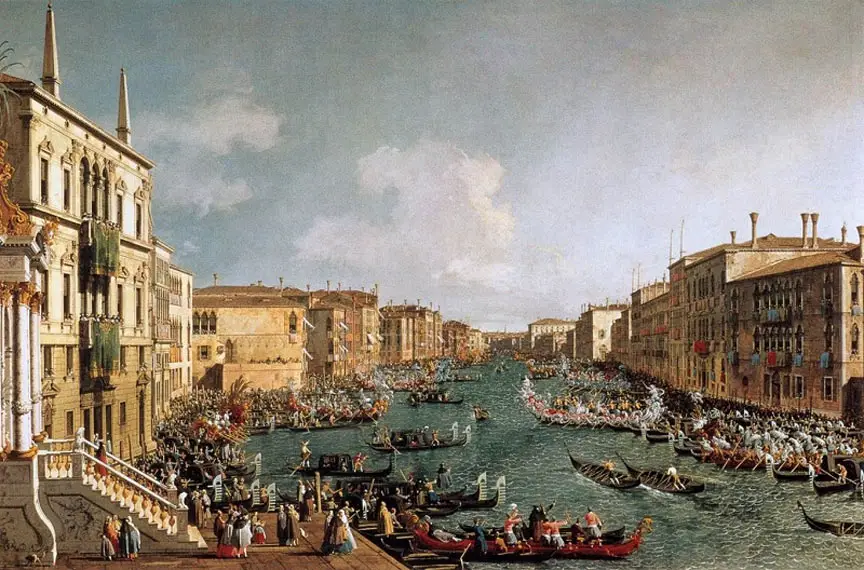
Historical Regatta - (Photo by InVeniceToday)
Event on September 1st 2024
The Venice Historic Regatta is certainly a singular event due to the uniqueness of its location and the taste of ancient history that is handed down to each edition.
But approaching this show believing it is only commemoration and mere review of a bygone era would be the most gross mistake that the visitor can make. The Historical Regatta remains in fact the maximum moment of the rowing season that in these parts still scans the seasons, and together with the regattas of the Redeemer and of Burano and others that are held during the year, goes to form the calendar of a purely activity lagoon.
Venice Historical Regatta Program 2024
Friday 25th August
– Disnar of the Historical Regatta in different points of Venice, islands and mainland.
Everyone brings food to share with others. Organized by city and rowing associations. To book a table go to the Disnar.org website.
Thursday 31st August
– 17.30: Parade in the Grand Canal from Rialto to Salute for the presentation of the crews.
– 18.00: Blessing of the gondolini in Campo della Salute.
Sunday 3rd September
– 16.00: Historic procession from Bacino San Marco to the railway and back to Ca' Foscari.
– 16.30: Regatta de le Schie (children up to 10 years) from Rialto to Ca' Foscari.
– Regatta of the Maciarele Junior (children up to 12 years old) from San Stae to Ca' Foscari.
– Regatta of the Maciarele Senior (up to 14 years) from Punta della Dogana to Ca' Foscari.
– 16.50: Regatta of the very young on two-oared pupparini from Bacino San Marco to the paleto of Ca' Farsetti and arrival at Ca' Foscari.
– 17.10: Regatta of Six-oared caorline from Bacino San Marcuola to the paleto at San Marcuola and back to Ca' Foscari.
– Regatta of 8-oared galleons between Italian and foreign universities from Rialto to Ca' Foscari.
– 5.40 pm: Women's regatta on two-oared mascarete from Bacino San Marcuola to the paleto near San Marcuola and back to Ca' Foscari.
– 18.10: Men's Rrgatta on two-oared gondolini from Bacino San Marcuola to the paleto at San Marcuola and back to Ca' Foscari.
From where to see the Historical Regatta
For those who do not have a moored boat or a palace overlooking the Grand Canal, the solutions are given by the few spaces on the banks of the Grand Canal. In fact, the day of the Regatta is all a swarm of people who slip into the most diverse streets adjacent to the Grand Canal in the hope of finding a good and maybe quiet place. Which sometimes happens.
If, on the other hand, you do not want to get lost among the streets and the crowds of people, you can buy some places on the floating tribune in the Grand Canal in San Silvestro, just before the Rialto Bridge.

Rates Historical Regatta Tribune
For those who do not have a moored boat or a Palazzo on the Grand Canal, the solutions are given by the few spaces on the Banks of the Grand Canal. In fact, the day of the Regatta is teeming with people who slip into the most disparate calli adjacent to the Grand Canal in the hope of finding an outlet and therefore a good and perhaps quiet place. Which sometimes happens.
History of the Historical Regatta
The word regatta seems to derive from the verb aurigare with the meaning to compete even if other solutions are proposed as the one that wants the term to derive from the striped for the line formation of the boats at the start.
The Venetian word then passed to other Indo-European languages: English, German, Turkish, Afrikaans and Dutch Regatta, French R�gate, identical to Italian in Spanish and Portuguese.
Historically, the first news, fragmentary and confusing, come to us from the thirteenth century but only afterwards the Regatta enters right into the news being also represented by famous artists on their paintings vedutiste.
It is not difficult, however, to hypothesize that spontaneous races of sailors in the lagoon and along the canals have always been born; the racing boat is in fact very similar to sandal, a flat-bottomed boat similar to footwear (sandalium in Latin), which results from documents already in use as a means of displacement from the sixth century. A.D.
Over the centuries the importance of the regatta grew so much that it was also portrayed in the famous Venice Plant by Jacopo De Barberi (1500) which thus inaugurated a pictorial subject that always received considerable success. Canaletto himself ventured to portray the Historical Regatta in the Grand Canal in 1732.
The regattas then characterized for more than six centuries the life of Venice celebrating lavish events and political events of importance such as that which was organized by the Serenissima for the Queen of Cyprus Caterina Cornaro, who had returned to the throne donated Cyprus to Venice (1489), a a very welcome gift given the strategic position of the island along the trade routes to the East.
With the fall of the Serenissima even the regattas experienced a crisis, even if the French did not resist the charm of the oar organizing a regatta for the wife of Bonaparte (1797) and then for the same Emperor (1807) visiting Venice.
The Regatta as it appears today, begins to take shape in the nineteenth century, when under the Austrian regime resumed competitions along the Grand Canal (1841) that had been interrupted with the fall of the Government of the Serenissima (1797). Later, when the mayor Filippo Grimani (1850 - 1921) inserted the event in the Biennale of Art, the words "Storica" ??were introduced to remember the glories and glories of the Serenissima (1899) and the historical procession of boats was also included of competitions.
Ceremonial procession of the Historical Regatta
The rowing competition is today proceeded by a procession of vintage boats with crews in traditional costumes crossing the Grand Canal in parade. This moment is intended to recall the magnificent procession that was organized by the Serenissima to the Queen of Cyprus Caterina Cornaro, who had previously donated her reign to Venice in 1489. On board the masked figures interpret Queen Caterina Cornaro, the doge and the dogaressa, accompanied by the highest offices of the Serenissima.
The Historical Regatta today
At the actual competition, different types of boats participate, but the most acclaimed is certainly the gondolini race brought by the champions that the whole city of Venice knows and admires. In the past, both remote and recent, there have been legendary names of champions who managed to win the Historical Regatta many times in their careers, becoming also king of the oar (title that comes with 5 consecutive victories). The winners are the glory and fame and cash prizes, in addition to the coveted flags: blue for the 4th classified (on which once appeared the pig to indicate a low speed), green for third classified, white per second (anciently light blue) and red for the winners.
Disnar of the Historical Regatta
The classic meeting place of the rowing world where everybody dine together at a public table a few days before the regatta. A tradition that has been repeated every year since the origins of the modern Historical Regatta in the mid-nineteenth century. The rowing champions participating in the regatta met at the table together with the organizers and authorities for the classic disnar (from the Old French disner; in turn from the Latin disieiunare with the meaning of «breaking the fast»); a moment in which it was also possible to understand the state of form of the opponents and have valuable information for the regatta.
Nowadays the tables are scattered throughout the city and everyone can participate by writing to the organizers of each single table chosen on the Disnar.org website. There are tables in Venice, the islands and the mainland. Each participant brings food for himself - and for the others if he wants - and comes into contact with the world of rowing by finding local rowing champions, rowing athletes of all ages. You can row with champions and dine with them.
King of the oar
– Luigi Zanellato (1881, 1889, 1890, 1891 and 1892)
– Albino dei Rossi known as Strigheta and Marcello Bon, known as Ciapate, (1947, 1948, 1949, 1950, 1951, 1952)
– Giuseppe Fongher called Bepi and Sergio Tagliapietra known as Ciaci (1969, 1970, 1971, 1972, 1973, 1974, 1975, 1976
– Palmiro Fongher and Gianfranco Vianello called Crea (1977, 1978, 1979, 1980, 1981, 1982, 1983)

(I Re del Remo: da sinistra Gianfranco Vianello detto Crea, Palmiro Fongher, Sergio Tagliapietra detto Ciaci, Giuseppe Fongher detto Bepi, Marcello Bon detto Ciapate, Albino dei Rossi detto Strigheta. Foto © Gigio Zanon))
Queens of the Oar
– Anna Mao e Romina Ardit (1997, 1998, 1999, 2000, 2001, 2002, 2003, 2004)
– Luisella Schiavon and Giorgia Ragazzi (2009, 2010, 2011, 2012, 2013)
The regatta program
During the afternoon the program is really intense; there are various types of boats for each regatta, where there are 9 crews (one of the reserves is always present at the start in case of abandonment of a boat). This is the order of appearance of the boats at the departure of Bacino San Marco:
– Regatta of the Maciarele Schie (children up to 10 years)
– Regatta of the Maciarele Junior (children up to 12 years)
– Regatta of the Maciarele Senior (up to 14 years)
– Regatta of the very young on pupparini with two oars
– Regatta of the caorline with six oars
– Regatta of 8-oared galleons between Italian and foreign universities
– Women's regatta on two-oared mascarete
– Men's regatta on two-oared gondolini
Route of the Historical Regatta
The departure is from the San Marco Basin in front of the Gardens of San Marco where is the so-called spagheto, that is the thread aimed at marking the starting line. The boat procession then goes all the way along the Grand Canal passing under the Rialto Bridge to reach the paleto, that is a pole fixed at the bottom of the Grand Canal in front of the Santa Lucia Station. Here the boats veer (180 �) and often decide the final order upon arrival that is located along the Grand Canal in the vault de canal of Ca 'Foscari in front of the machina, a tribune of honor that houses all the personalities among the public and welcomes the winners for the awards in front of the press.
The important phases of the Historical Regatta
The Cavata: immediately after the starting shot in front of the San Marco Gardens the cavata begins, i.e. the first section of the regatta in which the boats have their own lane followed by a second section which establishes the order of entry into the Grand Canal. Here fate assigns the best lane but the sailors have to take into account the direction of the current and start at maximum speed to get ahead.
The Grand Canal: difficult but not impossible to pass each other in the Grand Canal but the stretch up to the paleto in front of the station usually sees the crews line up to give their all in the final stretch back. Above all in the Rialto vault we see the first skirmishes with the protection of the internal side of whoever is in front.
Last stretch up to the Volta di Canal: the stretch of the Grand Canal up to Ca' Foscari and in front of the machina is the straightest and allows - to the rowers who have the strength and the possibility - to try overtaking on the outside. Contact between boats is not uncommon; for this the judges here must pay close attention.
Race Awards
The first 4 classified crews are awarded cash prizes and traditional flags of different colors: red to the winners, white to the second (once it was light blue), green to the third and blue to the quarters (a yellow time with piglet depicted). But the most coveted prize is certainly the fame and the glory that accompany the winners for a whole year during which they are admired by all the lagoon regattas and by the entire citizenship.
In fourth place until 2002 a pig was also offered, symbol in this case of slowness but then, following protests by some animalist groups, it was decided to replace the animal with a piglet made of glass by the Promovetro Consortium of Murano.
The colors of the racing boats
The racing boats are totally painted monochrome according to a tradition that linked them to the Sestieri of Venice and the islands of the lagoon. Each boat is then distinguished by a number that corresponds to a position in the race course at the start from San Marco; this number is assigned by drawing lots to avoid favoritism due to the particular current and tide conditions. Only the reserve boat has two colors, red and green, and the letter R (to signal the reserve boat) instead of the number. Colors and numbers are so associated:
1 - White
2 - Yellow or Canary
3 - Viola
4 - Celeste
5 - Red
6 - Green
7 - Orange
8 - Rose
9 - Brown
R - Green and Red
Roll of Honor Women Historical Regatta of recent years
The first twenty years of the 20th century saw the domination of 2 couples so that all 4 athletes became queens of the oar: Anna Mao and Romina Ardit (1997, 1998, 1999, 2000, 2001, 2002, 2003, 2004) and Luisella Schiavon and Giorgia Ragazzi (2009, 2010, 2011, 2012, 2013). But there was also room for other female sailors such as Valentina Tosi, Debora Scarpa and Gloria Rogliani. Tosi also won the last regatta with the Ragazzi.
2022: Valentina Tosi – Giorgia Ragazzi: 36:57.13
2021: Romina Ardit – Anna Mao: 35.31.24
2020: Romina Ardit – Anna Mao
2019: Elena Costantini – Elisa Costantini
2018: Romina Ardit – Anna Mao
2017: Romina Ardit – Anna Mao
2016: Romina Ardit – Anna Mao
2015: Valentina Tosi – Giorgia Ragazzi
2014: Valentina Tosi – Debora Scarpa
2013: Luisella Schiavon
– Giorgia Ragazzi
2012:
Luisella Schiavon
– Giorgia Ragazzi
2011: Luisella Schiavon
– Giorgia Ragazzi
2010: Luisella Schiavon
– Giorgia Ragazzi
2009: Luisella Schiavon
– Giorgia Ragazzi
2008:
Gloria Rogliani
– Debora Scarpa
2007: Luisella Schiavon
– Giorgia Ragazzi
2006: Valentina Tosi
– Zanella Germana
2005: Rogliani Gloria
– Scarpa Debora
2004: Romina Ardit – Anna Mao
2003: Romina Ardit – Anna Mao
2002: Romina Ardit – Anna Mao
2001: Romina Ardit – Anna Mao
2000: Romina Ardit – Anna Mao
Roll of Honor Men Historical Regatta of recent years
Practically a dialogue between 4 persons the first position of the Historical Regatta in this century. But in the last few rowing seasons, first the couple Bertoldini Andrea - Colombi Mattia and then the couple of the Vignotto family prevailed::
2024: Andrea Ortica – Jacopo Colombi: 32:01.27
2021: Rudi Vignotto – Mattia Vignotto: 30.31.4
2020: Andrea Bertoldini - Mattia Colombi
2019: Andrea Bertoldini - Mattia Colombi
2018: Rudy Vignotto - Giampaolo D'este
2017: Rudy Vignotto - Igor Vignotto
2016: Rudy Vignotto - Igor Vignotto
2015: Rudy Vignotto - Igor Vignotto
2014: Ivo Redolfi Tezzat - Giampaolo D'este
2013: Rudy Vignotto - Igor Vignotto
2012: Rudy Vignotto - Igor Vignotto
2011: Ivo Redolfi Tezzat - Giampaolo D'este
2010: Rudy Vignotto - Igor Vignotto
2009: Rudy Vignotto - Igor Vignotto
2008: Ivo Redolfi Tezzat - Giampaolo D'este
2007: Ivo Redolfi Tezzat - Giampaolo D'este
2006: Ivo Redolfi Tezzat - Giampaolo D'este
2005: Ivo Redolfi Tezzat - Giampaolo D'este
2004: Rudy Vignotto - Igor Vignotto
2003: Ivo Redolfi Tezzat - Giampaolo D'este
2002: Rudy Vignotto - Igor Vignotto
2001: Rudy Vignotto - Igor Vignotto
2000: Rudy Vignotto - Igor Vignotto
Web site: Historical Regatta

Giovanni Antonio Canal detto il Canaletto (Regata sul Canal Grande,
1732) |